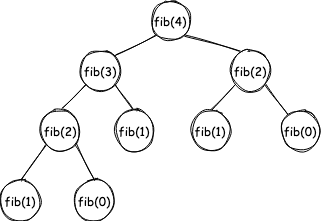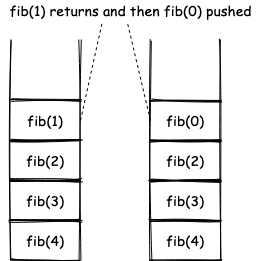Space Complexity
It can be defined as:
Order of growth of memory space in terms of input size.
Let’s consider some examples:
def sum(n):
return n * (n + 1)//2
The space complexity is since only 1 variable is needed.
def sum2(n):
sum = 0
for i in range(1, n+1):
sum += i
return sum
The space complexity is still since only 3 variables are needed.
def arrSum(arr):
sum = 0
for i in arr:
sum += i
return sum
The space complexity is since we need array of size .
Auxiliary Space
Order of growth of extra space (any space other than needed for input and output) in terms of input size.
For the earlier arrSum example, aux space is
and space complexity is
.
For arrays and lists, the space complexity is anyways going to be .
Therefore, auxiliary space is an important criteria in analysis.
Consider the following function:
def recSum(n):
if n <= 0:
return 0
return n + recSum(n - 1)
The function call stack for the invocation recSum(5) can be visualized as follows:

The number of stack frames is .
The space complexity: .
Aux space: .
Consider the following fibonacci implementation:
def fib(n):
if n == 0 or n == 1:
return n
return fib(n - 1) + fib(n - 2)
Expected results for values of :
| n = 0 | n = 1 | n = 2 | n = 3 | n = 4 | n = 5 | n = 6 |
|---|---|---|---|---|---|---|
| 0 | 1 | 1 | 2 | 3 | 5 | 8 |
Here is how the recursion tree will look like for fib(4) execution:

Let’s see how the call stack looks like for fib(4) execution:

As we can see, the maximum number of active stack frames is i.e. height of tree.
Therefore aux space = .
The simple rule to find out the aux space for recursion: it’s always equal to the height of the recursion tree.
Consider the following non-recursive implementation for fibonacci:
def fib2(n):
f = [None for _ in range(n)]
f[0], f[1] = 0, 1
for i in range(2, n):
f[i] = f[i-1] + f[i-2]
return f[n-1]
Space complexity: .
Aux space: .
Can we reduce the aux space needed?
Conside the following implementation:
def fib3(n):
if n == 0 or n == 1:
return n
a, b, c = 0, 1, 0
for i in range(2, n + 1):
c = a + b
a, b = b, c
print(f"i={i}; c={c}, a={a}, b={b}")
return c
Here is variable tracing looks like for above implementation for :
a=0, b=1, c=0
i=2; c=1, a=1, b=1
i=3; c=2, a=1, b=2
i=4; c=3, a=2, b=3
Space complexity: .
Aux space : .